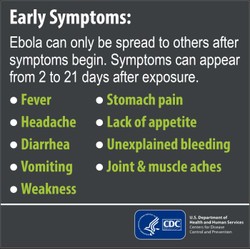The clinical presentation of those who have acquired Ebola virus disease resembles several other illnesses. For example, it will likely overlap with signs and symptoms of malaria and influenza. Since malaria can occur in Africa where Ebola virus is also present, the physician has the challenge of making a distinction between the two [1, 2].
There may be fever, weakness, muscle pain, headache, and sore throat. Later in the course of Ebola virus disease, the client may experience vomiting, diarrhea, rash, and organ failure such as liver and kidneys. Moreover, internal and external bleeding can take place in people who have this medical condition [1, 2].




 The Reality of Aspirinon 05/24/2021
The Reality of Aspirinon 05/24/2021
 An Old Microbeon 03/31/2021
An Old Microbeon 03/31/2021
 Coronavirus and Mental Illnesson 02/14/2021
Coronavirus and Mental Illnesson 02/14/2021
 Acute Ischemic Strokeon 12/25/2020
Acute Ischemic Strokeon 12/25/2020


Comments